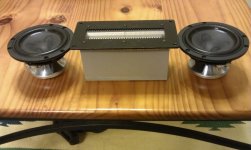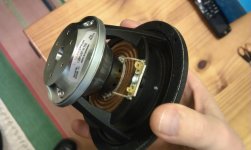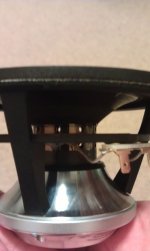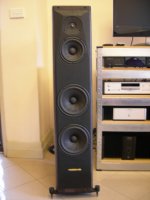I am not an expert but here are my comments. The usual concerns which are well written about are the frequency hump caused by the baffle. The humps' freq is determined by the baffle width. Look for Martin King's "Designing a Passive Two Way Open Baffle Speaker" for a very good explanation of the problem and a simple solution for it. There is the question of whether to make the tweeter dipole or stick with the usual monopole tweeter. Linkwitz started with monopole and then later mounted an out of phase identical tweeter on the back of his open baffle Orions. Then there is the bass cancellation problem as you go lower in frequency. That is why everyone says you need a big woofer. The woofer has to work harder and harder as you go lower in frequency, and even with large drivers it is very hard to get to 20 hz. However, you can use smaller woofers and cross to a standard subwoofer at 80 to 150 hz.
One thing that I don't see mentioned often is the fact that Qts isn't the final judge of a bass speaker's open baffle worthiness. It is the amount of air a bass speaker can push that matters most. Two speakers, one with low Qts the other high, that can both sweep the same volume of air, will produce the same max volume of sound. The Qts makes a difference in how the speaker rolls off in frequency as the frequency goes down. High Qts on an infinite baffle will have a rising freq response, so when you put it on an open baffle, it helps cancel out the 6 db roll off caused by the open baffle. If the Qts is high enough, you don't even need to use EQ to get a flat bass response (yes, the cone of a high Qts speaker moves farther in and out, sweeping s greater volume of air, as frequency decreases even though the voltage across it is not increasing). If your driver has a low Qts, you can still use it, but you have to EQ the response to get it flat. However, the one problem I ran into when I tried to use a low Qts driver was that if the surround of the driver is too loose, it can let the speaker bottom out even when the driver is not being driven hard enough, just because the cone "flops" around too much without the restoring force of the air in a cabinet. Some Pro speakers have somewhat stiff suspensions but low Qts. With EQ, they would make great OB bass drivers. So, don't give up on your bass speaker just because its Qts is low.
James
One thing that I don't see mentioned often is the fact that Qts isn't the final judge of a bass speaker's open baffle worthiness. It is the amount of air a bass speaker can push that matters most. Two speakers, one with low Qts the other high, that can both sweep the same volume of air, will produce the same max volume of sound. The Qts makes a difference in how the speaker rolls off in frequency as the frequency goes down. High Qts on an infinite baffle will have a rising freq response, so when you put it on an open baffle, it helps cancel out the 6 db roll off caused by the open baffle. If the Qts is high enough, you don't even need to use EQ to get a flat bass response (yes, the cone of a high Qts speaker moves farther in and out, sweeping s greater volume of air, as frequency decreases even though the voltage across it is not increasing). If your driver has a low Qts, you can still use it, but you have to EQ the response to get it flat. However, the one problem I ran into when I tried to use a low Qts driver was that if the surround of the driver is too loose, it can let the speaker bottom out even when the driver is not being driven hard enough, just because the cone "flops" around too much without the restoring force of the air in a cabinet. Some Pro speakers have somewhat stiff suspensions but low Qts. With EQ, they would make great OB bass drivers. So, don't give up on your bass speaker just because its Qts is low.
James
Thanks James for that info...
Not so much interested in OB for bass but more for tweeter and mids to cover the voice range.
Just looking at the specs for the 8ohm 12MU and reads as follows.
Linear excursion = +- 3.4mm Max mech excursion +-11mm
For the 4ohm version of same driver
Linear excursion +- 3.5mm and Max mech excursion = +- 10mm
As you can see both the 8 and 4 ohm versions both have a very limited X-max.
Just to provide some context to what I am proposing here are a couple of photo of the drivers.
Not so much interested in OB for bass but more for tweeter and mids to cover the voice range.
Just looking at the specs for the 8ohm 12MU and reads as follows.
Linear excursion = +- 3.4mm Max mech excursion +-11mm
For the 4ohm version of same driver
Linear excursion +- 3.5mm and Max mech excursion = +- 10mm
As you can see both the 8 and 4 ohm versions both have a very limited X-max.
Just to provide some context to what I am proposing here are a couple of photo of the drivers.
Attachments
StigErik I can't quite make out if your photo is showing the front or the back of the baffle. Do you prefer the back of the driver to be nearest the tweeter or the front?
Its the front. But the order of the drivers do not matter.
Thanks James for that info...
Not so much interested in OB for bass but more for tweeter and mids to cover the voice range.
Just looking at the specs for the 8ohm 12MU and reads as follows.
Linear excursion = +- 3.4mm Max mech excursion +-11mm
Xmax is fine for midrange use, down to maybe 3-400 Hz.
Why not OB bass? In my opinion, its the bass range where OB's have their strongest advantages.
There is one good reason for doing push pull with both woofers and midranges, and that is distortion reduction. Odd order harmonics are reduced with a factor up to 10 because of phase cancellation of the distortion products between the drivers.
That would be even order cancelation.
Finally fired up my speakers for the first time since buying all the gear months ago. Working out a basic crossover on the DCN28 was a bit easier than I expected.
So I put together a single speaker comprising of 1 x RAAL 140-15D AM, 2 x 12MU8731 in parallel, and 1 x Vifa 10" hard paper driver I had from a long abandoned project.
I don't have a baffle made yet as I was only getting them running to hear what the tweeter sounded like (very very nice ) Being the tweeter really does like to crossover around that 1600-1800Hz range I wish I would have bought some larger diameter mids.
) Being the tweeter really does like to crossover around that 1600-1800Hz range I wish I would have bought some larger diameter mids.
The Vifa 10" is 88.2dB from memory and needed some serious gain to match the mids and tweeter, but by the time I added 10dB of gain it kicked the crap out of the top end and sounded muffled.
So as a compromise I set it to 5dB and it sounds ok. It came as no surprise to me that the woofer would be less than optimal not mounted to a baffle, and I can already see why I would need some big woofers if I wanted to go OB on the sub frequencies.
Next step is to try put together some kind of basic OB this weekend. StigErik on the picture where the speakers are held by wire was that successful?
So I put together a single speaker comprising of 1 x RAAL 140-15D AM, 2 x 12MU8731 in parallel, and 1 x Vifa 10" hard paper driver I had from a long abandoned project.
I don't have a baffle made yet as I was only getting them running to hear what the tweeter sounded like (very very nice
The Vifa 10" is 88.2dB from memory and needed some serious gain to match the mids and tweeter, but by the time I added 10dB of gain it kicked the crap out of the top end and sounded muffled.
So as a compromise I set it to 5dB and it sounds ok. It came as no surprise to me that the woofer would be less than optimal not mounted to a baffle, and I can already see why I would need some big woofers if I wanted to go OB on the sub frequencies.
Next step is to try put together some kind of basic OB this weekend. StigErik on the picture where the speakers are held by wire was that successful?
Last edited:
Have 4 channels available both sides, not really sure if I would attempt a 4 way or a 3 way with sub, I am more geared towards music then I am movies, but then I really don't want it lacking come movie time either.
So perhaps replace the 12MU in the front for something in the 6" range, some 10s for mid bass and some 15s for lets shake the walls?
Edit:
Or perhaps keep the 12MUs use some 8" for mid bass?
So perhaps replace the 12MU in the front for something in the 6" range, some 10s for mid bass and some 15s for lets shake the walls?
Edit:
Or perhaps keep the 12MUs use some 8" for mid bass?
Last edited:
Next step is to try put together some kind of basic OB this weekend. StigErik on the picture where the speakers are held by wire was that successful?
I'm not StigErik but I have 4-way dipoles, with the upper 3 ways suspended by wire. I can tell you that it works quite well, it just takes a good bit of eq to get a flat response.
Thanks Nate do you have any pictures?
Lying in bed last night trying to get to sleep my head was overrun by questions…
When building in a typical cabinet there seems to be a space between the mid / tweeter and the bass is that still applicable when there is no baffle?
Do the speakers move when played loud?
Does the wire vibrate?
Could you use a piece of steel pipe and make an upside down U and suspend the speakers from that cutting down on the length of wire?
I was also thinking of making the hoop out of wood, since I have a decent router and skills to build it.
Is there a calulatable loss to the bass if it is suspended?
Lying in bed last night trying to get to sleep my head was overrun by questions…
When building in a typical cabinet there seems to be a space between the mid / tweeter and the bass is that still applicable when there is no baffle?
Do the speakers move when played loud?
Does the wire vibrate?
Could you use a piece of steel pipe and make an upside down U and suspend the speakers from that cutting down on the length of wire?
I was also thinking of making the hoop out of wood, since I have a decent router and skills to build it.
Is there a calulatable loss to the bass if it is suspended?
I'll try to put up some pics tomorrow.
When you say space are you talking about front to back offset of the drivers - time alignment? I use planar drivers for upper mid and tweet so alignment is simple. Alignment with the lower mid is not so simple. John k used to have an article about time alignment of dipoles on musicanddesign.com but I can't seem to access that article now........basically you need to consider the front AND rear alignment, and digital delay is no good here because it offsets the rear response in the wrong direction.
No, the drivers don't move. Basically by suspending them the forces cancel. However, my 15" woofers are in a u-frame. I don't see any benefit to suspending the woofers "nude", you just throw away your lower extension and eff even more so than if they were baffled.
When you say space are you talking about front to back offset of the drivers - time alignment? I use planar drivers for upper mid and tweet so alignment is simple. Alignment with the lower mid is not so simple. John k used to have an article about time alignment of dipoles on musicanddesign.com but I can't seem to access that article now........basically you need to consider the front AND rear alignment, and digital delay is no good here because it offsets the rear response in the wrong direction.
No, the drivers don't move. Basically by suspending them the forces cancel. However, my 15" woofers are in a u-frame. I don't see any benefit to suspending the woofers "nude", you just throw away your lower extension and eff even more so than if they were baffled.
No I was actually refering to the vertical spacing. As you can see in my current speakers there is a gap between the mid and the woofers. Was wondering if that was still required in OB /NB.
But on time allignment I notice in StigErik's photos he aligns the drivers pretty much on the front face plate and was wonderig if that was the most "ideal" place, or just the most convenient with the screw holes being there.
Or should you be shooting for mid distance on the cone height as the crossover point?
But on time allignment I notice in StigErik's photos he aligns the drivers pretty much on the front face plate and was wonderig if that was the most "ideal" place, or just the most convenient with the screw holes being there.
Or should you be shooting for mid distance on the cone height as the crossover point?
Attachments
i know it just seems strange, how will u get bass if no pressure from the box.
you could do some audition to get a feel of OB, the speaker that lead me to OB was Jamo R909, i was very very impressed with the sound, the only speaker close to it was ATC sealed scm50 active in terms of bass. i cant adford any of those speakers :d, so i look for more info about OB, then ive tried the eminence beta and alpha, it works. i cant say its as good as jamo, but definitely within the ballpark.
you could do some audition to get a feel of OB, the speaker that lead me to OB was Jamo R909, i was very very impressed with the sound, the only speaker close to it was ATC sealed scm50 active in terms of bass. i cant adford any of those speakers :d, so i look for more info about OB, then ive tried the eminence beta and alpha, it works. i cant say its as good as jamo, but definitely within the ballpark.
How would a pair of these go as mid-woofers? http://www.speakerbits.com/index.ph...1208&manufacturer_id=15&option=com_virtuemart
I'm looking at buying 10 of them. These are basically the Illuminator verson of what I have in the Cremonas. I notice that 8" seems to be a popular size for mid woofers is 6.5 close enough?
I'm looking at buying 10 of them. These are basically the Illuminator verson of what I have in the Cremonas. I notice that 8" seems to be a popular size for mid woofers is 6.5 close enough?
- Status
- This old topic is closed. If you want to reopen this topic, contact a moderator using the "Report Post" button.
- Home
- Loudspeakers
- Multi-Way
- First time OB builder



